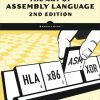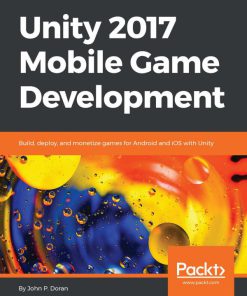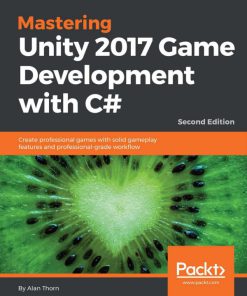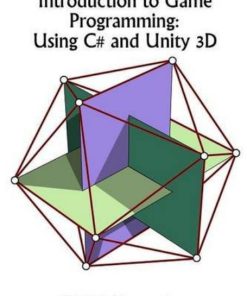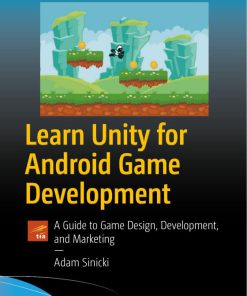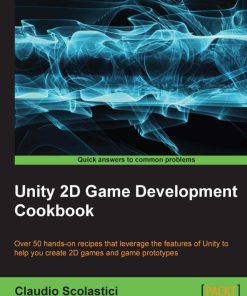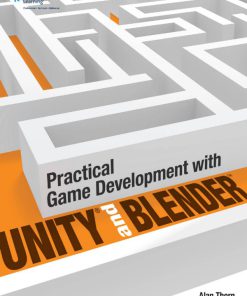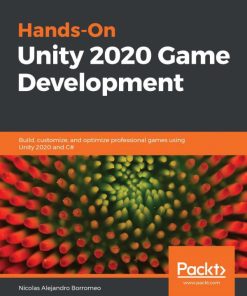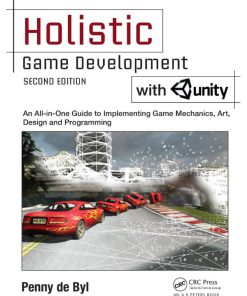(Ebook PDF) Introduction to Game Design Prototyping and Development From Concept to Playable Game with Unity and C 1st edition by Jeremy Gibson Bond 0136619851 9780136619857 full chapters
$50.00 Original price was: $50.00.$25.00Current price is: $25.00.
Authors:Jeremy Gibson Bond , Series:Gaming [34] , Author sort:Bond, Jeremy Gibson , Ids:9780134659886 , Languages:Languages:eng , Published:Published:Aug 2017 , Publisher:Pearson Education
Introduction to Game Design, Prototyping, and Development: From Concept to Playable Game with Unity and C# 1st edition by Jeremy Gibson Bond – Ebook PDF Instant Download/DeliveryISBN: 0136619851, 9780136619857
Full download Introduction to Game Design, Prototyping, and Development: From Concept to Playable Game with Unity and C# 1st edition after payment.
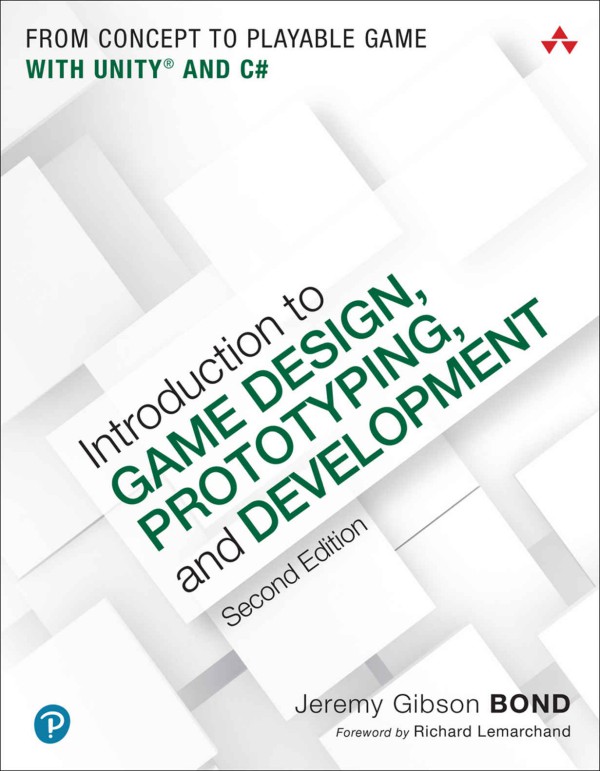
Product details:
ISBN-10 : 0136619851
ISBN-13 : 9780136619857
Author : Jeremy Gibson Bond
Learn All the Design & Development Skills You Need to Make Great Games with Unity, the World’s Most Popular Professional Game Engine If you want to design and develop games, there is no substitute for strong, hands-on experience with modern techniques and tools. That is exactly what this book provides. Leading instructor and indie game developer Jeremy Gibson Bond covers all three disciplines that you need to succeed: game design theory, rapid iterative prototyping, and practical programming. Building on two previous best-sellers, this Third Edition contains hundreds of improvements across more than 400 new pages, all designed to make it even easier to understand and more useful in modern game development.
Introduction to Game Design, Prototyping, and Development: From Concept to Playable Game with Unity and C# 1st Table of contents:
Part I Game Design and Paper Prototyping
1 Thinking Like a Designer
You Are a Game Designer
Bartok: A Game Design Exercise
The Definition of Game
Summary
2 Game Analysis Frameworks
Common Frameworks for Ludology
MDA: Mechanics, Dynamics, and Aesthetics
Formal, Dramatic, and Dynamic Elements
The Elemental Tetrad
Summary
3 The Layered Tetrad
The Inscribed Layer
The Dynamic Layer
The Cultural Layer
The Responsibility of the Designer
Summary
4 The Inscribed Layer
Inscribed Mechanics
Inscribed Aesthetics
Inscribed Narrative
Inscribed Technology
Summary
5 The Dynamic Layer
The Role of the Player
Emergence
Dynamic Mechanics
Dynamic Aesthetics
Dynamic Narrative
Dynamic Technology
Summary
6 The Cultural Layer
Beyond Play
Cultural Mechanics
Cultural Aesthetics
Cultural Narrative
Cultural Technology
Authorized Transmedia Are Not Part of the Cultural Layer
The Cultural Impact of a Game
Summary
7 Acting Like a Designer
Iterative Design
Innovation
Brainstorming and Ideation
Changing Your Mind
Scoping!
Summary
8 Design Goals
Design Goals: An Incomplete List
Designer-Centric Goals
Player-Centric Goals
Summary
9 Paper Prototyping
The Benefits of Paper Prototyping
Paper Prototyping Tools
Paper Prototyping for Interfaces
A Paper Prototype Example
Best Uses for Paper Prototyping
Poor Uses for Paper Prototyping
Summary
10 Game Testing
Why Playtest?
Being a Great Playtester Yourself
The Circles of Playtesters
Methods of Playtesting
Other Important Types of Testing
Summary
11 Math and Game Balance
The Meaning of Game Balance
The Importance of Spreadsheets
Examining Dice Probability with Sheets
The Math of Probability
Randomizer Technologies in Paper Games
Weighted Distributions
Weighted Probability in Google Sheets
Permutations
Using Sheets to Balance Weapons
Positive and Negative Feedback
Summary
12 Guiding the Player
Direct Guidance
Indirect Guidance
Teaching New Skills and Concepts
Summary
13 Puzzle Design
Scott Kim on Puzzle Design
The Steps of Solving a Puzzle
Puzzle Examples in Action Games
Designing and Developing Puzzle Games
Summary
14 The Agile Mentality
The Manifesto for Agile Software Development
Scrum Methodology
Burndown Chart Example
Creating Your Own Burndown Charts
Summary
15 The Digital Game Industry
About the Game Industry
Game Education
Getting Into the Industry
Don’t Wait to Start Making Games!
Summary
Part II Programming C# in Unity
16 Thinking in Digital Systems
Systems Thinking in Board Games
An Exercise in Simple Instructions
Game Analysis: Apple Picker
Summary
17 Introducing Unity Hub and the Unity Editor
Downloading Unity
Introducing Our Development Environment
Creating a Unity Account
Checking Out a Sample Project
Creating Your First Unity Project
Learning Your Way Around Unity
Setting Up the Unity Window Layout
Summary
18 Introducing Our Language: C#
Understanding the Features of C#
Reading and Understanding C# Syntax
Summary
19 Hello World: Your First Program
Creating a New Project
Making a New C# Script
Making Things More Interesting
Summary
20 Variables and Components
Introducing Variables
Statically Typed Variables in C#
Important C# Variable Types
The Scope of Variables
Naming Conventions
Important Unity Variable Types
Unity GameObjects and Components
Summary
21 Boolean Operations and Conditionals
Booleans
Comparison Operators
Conditional Statements
Summary
22 Loops
Types of Loops
Set Up a Project
while Loops
do…while Loops
for Loops
foreach Loops
Jump Statements within Loops
Summary
23 Collections in C#
C# Collections
Using Generic Collections
List
Dictionary
Array
Multidimensional Arrays
Jagged Arrays
Jagged Lists
Choosing Whether to Use an Array or List
Summary
24 Functions and Parameters
Setting Up the Function Examples Project
Definition of a Function
What Happens When You Call a Function?
Function Parameters and Arguments
Returning Values
Returning void
Function Naming Conventions
Why Use Functions?
Function Overloading
Optional Parameters
The params Keyword
Recursive Functions
Summary
25 Debugging
Getting Started with Debugging
Stepping Through Code with the Debugger
Summary
26 Classes
Understanding Classes
Class Inheritance
Summary
27 Object-Oriented Thinking
The Object-Oriented Metaphor
An Object-Oriented Boids Implementation
Summary
28 Data-Oriented Design
The Theory of Data-Oriented Design
DOTS Tutorial and Example
The Future of Unity DOTS
Summary
Part III Game Prototype Tutorials
29 Apple Picker
What You Will Learn
The Apple Picker Prototype
The Purpose of a Digital Prototype
Preparing
Coding the Apple Picker Prototype
GUI and Game Management
Summary
30 Mission Demolition
What You Will Learn
The Mission Demolition Prototype
Getting Started: Mission Demolition
Game Prototype Concept
Art Assets
Coding the Prototype
From Prototype to First Playable
Summary
31 Space shmup – Part 1
What You Will Learn
Getting Started: Space SHMUP
Setting the Scene
Making the Hero Ship
Adding Some Enemies
Spawning Enemies at Random
Setting Tags, Layers, and Physics
Making the Enemies Damage the Player
Restarting the Game
Shooting (Finally)
Summary
32 Space SHMUP – Part 2
What You Will Learn
Getting Started: Space SHMUP – Part 2
Enemy to Enemy_0
Programming Other Enemies
Shooting Revisited
Showing Enemy Damage
Adding PowerUps and Boosting Weapons
Race Conditions & Script Execution Order
Making Enemies Drop PowerUps
Enemy_4 — A More Complex Enemy
Tuning Settings for the Game Entities
Adding a Scrolling Starfield Background
Summary
33 Prospector Solitaire – Part 1
What You Will Learn
The Prospector Game
Getting Started: Prospector Solitaire
Build Settings
Setting Up the Unity Window Layout
Setting Up the Camera and Game Pane
Importing Images as Sprites
Constructing Cards from Sprites
Implementing Prospector in Code
Implementing Game Logic
Summary
34 Prospector Solitaire – Part 2
What You Will Learn
Getting Started: Prospector – Part 2
Additional Prospector Game Elements
Adding GUI Elements to Display the Score
Building and Running Your WebGL Build
Summary
35 Dungeon Delver – Part 1
What You Will Learn
The Dungeon Delver Game
Getting Started: Dungeon Delver
Setting Up the Cameras
Understanding the Dungeon Data
Showing the Map with a Unity Tilemap
Adding the Hero
Giving Dray an Attack Animation
Dray’s Sword
Programmatic Collision in Unity Tilemap
The InRoom Script
Enemy: Skeletos
Keeping GameObjects in the Room
Aligning to the Grid
Moving from Room to Room
Making the Camera Follow Dray
Summary
36 Dungeon Delver – Part 2
What You Will Learn
Getting Started: Dungeon Delver — Part 2
Dungeon Delver — Part 2 Overview
Implementing TileSwaps
Swapping in LockedDoor GameObjects
Implementing Keys and Unlocking Doors
Adding GUI to Track Key Count and Health
Enabling Enemies to Damage Dray
Making Dray’s Attack Damage Enemies
Modifying Enemy to Take Damage
Picking Up Items
Enemies Dropping Items on Death
Implementing a New Dungeon — The Hat
Implementing a Grappler
Summary
Part IV Next Steps
37 Coding Challenges
What Is a Coding Challenge?
Getting Started on a Coding Challenge
Filling in the Blanks
How to Approach Each Challenge
38 Beyond This Book
Continue to Learn Unity Development
Build a Classic Game
Start a Small Game Project or Prototype
Make Games for Lifelong Enrichment
Consider Going to School for GameDev
Explore Advanced Game Design
Finally, Drop Me a Line
Index
Part V Online Appendices — https://book.prototools.net or informit.com/title/9780136619949
A Standard Project Setup Procedure
The Set Up Sidebar for Tutorial Projects
Setting Up a New Project
Importing a Starter UnityPackage
Setting the Scene Name
Setting the Game Pane to Full HD (1080p)
Setting Up a WebGL Build
Understanding Unity Version Control
Summary
B Useful Concepts
Topics Covered
C# and Unity Coding Concepts
Math Concepts
Pen-and-Paper Roleplaying Games
User Interface Concepts
C Online Reference
Tutorials
Unite Conference
Unity’s YouTube Channel
Programming
Searching Tips
Finding and Creating Assets
Other Tools and Educational Discounts
D Tips for Teaching from This Book
The Goal of This Appendix
Teaching Introduction to Game Design
Teaching Introduction to Game Programming
More Information Is Available
People also search for Introduction to Game Design, Prototyping, and Development: From Concept to Playable Game with Unity and C# 1st:
what is prototyping in game development
what is prototyping with example
what is meant by prototyping
introduction to game design prototyping and development third edition
introduction to game design prototyping and development github


